Detailed Analysis of an Interest Rate Swap and Cost Savings
VerifiedAdded on 2022/09/12
|9
|1548
|22
Report
AI Summary
This report provides a detailed analysis of an interest rate swap between two companies, XX and YY. It begins by calculating the swap fixed rate and the total cost savings achieved through the swap arrangement. The analysis includes the distribution of these cost savings between the two companies. The report then delves into the calculation of the final fixed and floating rates for each company, highlighting the effective cost of borrowing. Furthermore, it calculates the swap payment based on the 6-month LIBOR rate. The report concludes with a discussion of the risks associated with interest rate swaps, including counterparty risk and the potential for default due to interest rate fluctuations or large notional amounts. The document uses references to support the assertions.
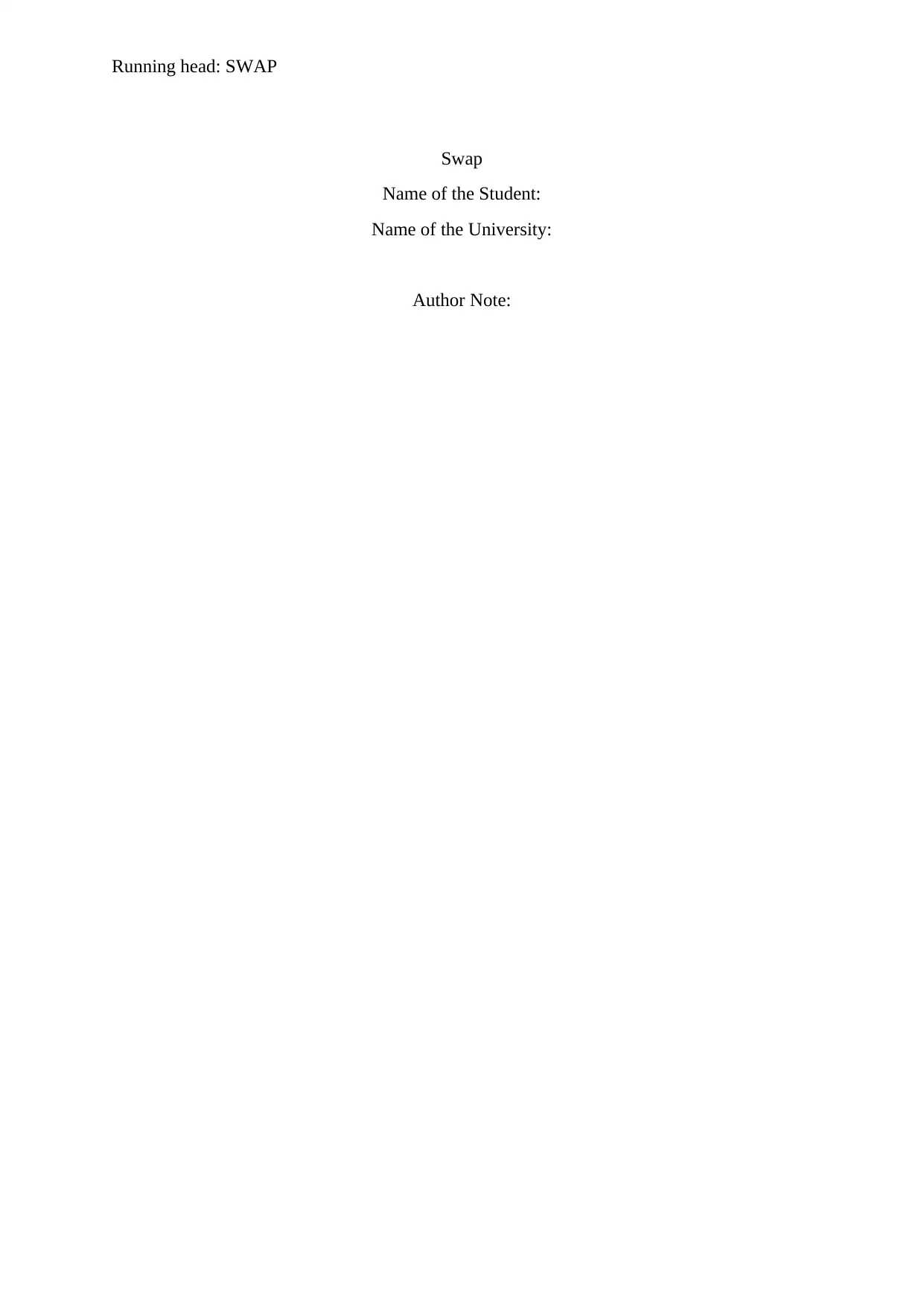
Running head: SWAP
Swap
Name of the Student:
Name of the University:
Author Note:
Swap
Name of the Student:
Name of the University:
Author Note:
Paraphrase This Document
Need a fresh take? Get an instant paraphrase of this document with our AI Paraphraser
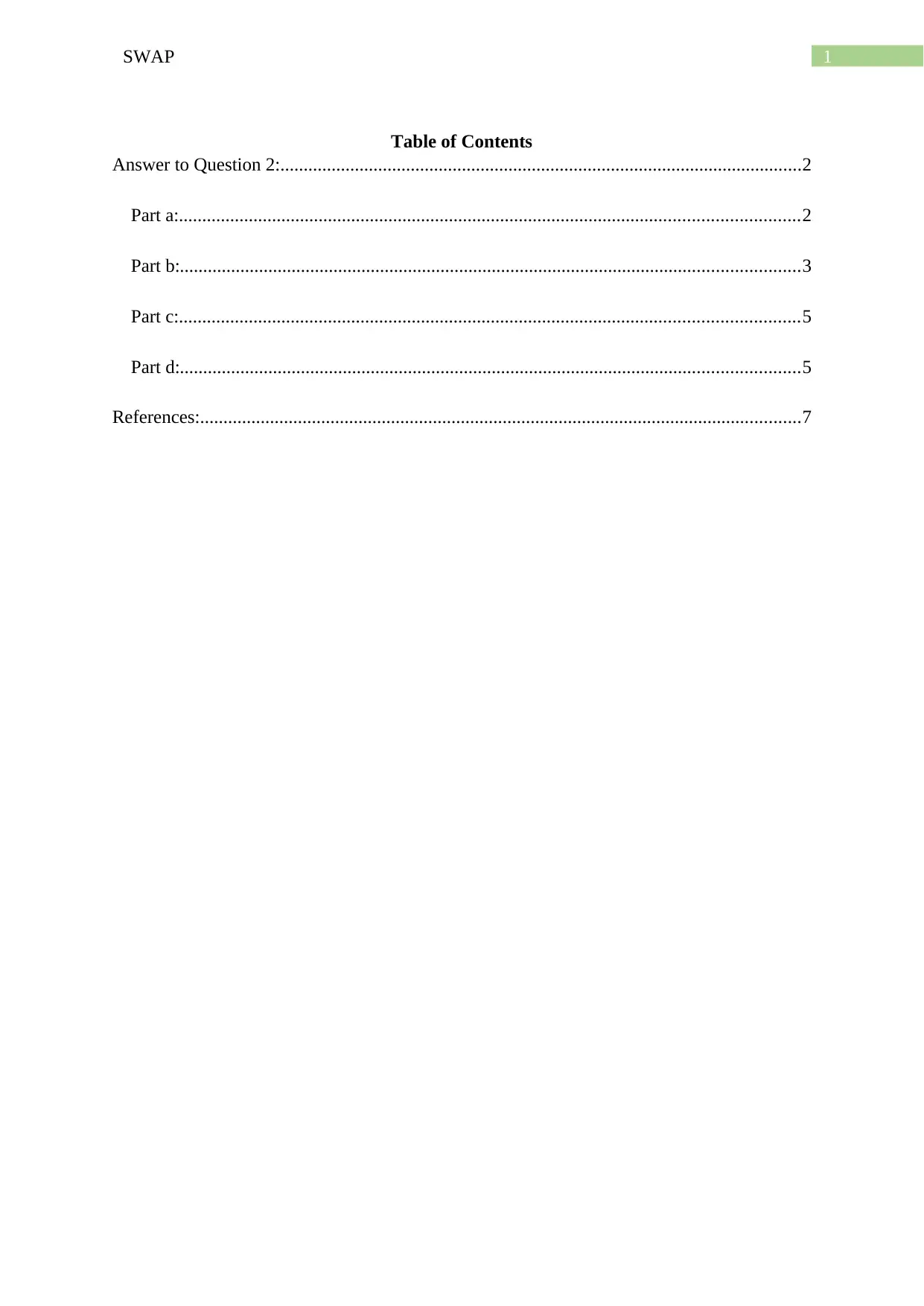
1SWAP
Table of Contents
Answer to Question 2:................................................................................................................2
Part a:.....................................................................................................................................2
Part b:.....................................................................................................................................3
Part c:.....................................................................................................................................5
Part d:.....................................................................................................................................5
References:.................................................................................................................................7
Table of Contents
Answer to Question 2:................................................................................................................2
Part a:.....................................................................................................................................2
Part b:.....................................................................................................................................3
Part c:.....................................................................................................................................5
Part d:.....................................................................................................................................5
References:.................................................................................................................................7
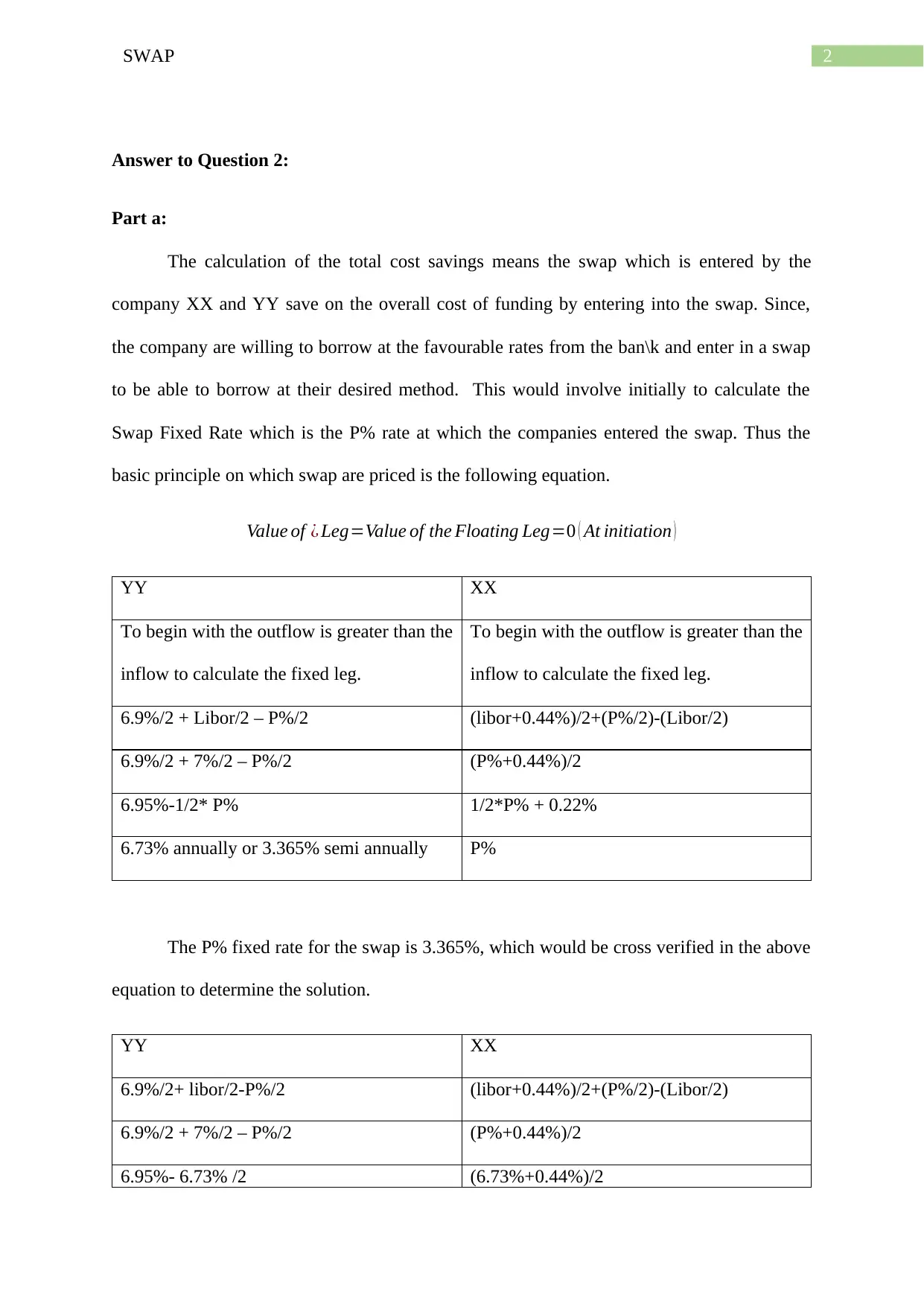
2SWAP
Answer to Question 2:
Part a:
The calculation of the total cost savings means the swap which is entered by the
company XX and YY save on the overall cost of funding by entering into the swap. Since,
the company are willing to borrow at the favourable rates from the ban\k and enter in a swap
to be able to borrow at their desired method. This would involve initially to calculate the
Swap Fixed Rate which is the P% rate at which the companies entered the swap. Thus the
basic principle on which swap are priced is the following equation.
Value of ¿ Leg=Value of the Floating Leg=0 ( At initiation )
YY XX
To begin with the outflow is greater than the
inflow to calculate the fixed leg.
To begin with the outflow is greater than the
inflow to calculate the fixed leg.
6.9%/2 + Libor/2 – P%/2 (libor+0.44%)/2+(P%/2)-(Libor/2)
6.9%/2 + 7%/2 – P%/2 (P%+0.44%)/2
6.95%-1/2* P% 1/2*P% + 0.22%
6.73% annually or 3.365% semi annually P%
The P% fixed rate for the swap is 3.365%, which would be cross verified in the above
equation to determine the solution.
YY XX
6.9%/2+ libor/2-P%/2 (libor+0.44%)/2+(P%/2)-(Libor/2)
6.9%/2 + 7%/2 – P%/2 (P%+0.44%)/2
6.95%- 6.73% /2 (6.73%+0.44%)/2
Answer to Question 2:
Part a:
The calculation of the total cost savings means the swap which is entered by the
company XX and YY save on the overall cost of funding by entering into the swap. Since,
the company are willing to borrow at the favourable rates from the ban\k and enter in a swap
to be able to borrow at their desired method. This would involve initially to calculate the
Swap Fixed Rate which is the P% rate at which the companies entered the swap. Thus the
basic principle on which swap are priced is the following equation.
Value of ¿ Leg=Value of the Floating Leg=0 ( At initiation )
YY XX
To begin with the outflow is greater than the
inflow to calculate the fixed leg.
To begin with the outflow is greater than the
inflow to calculate the fixed leg.
6.9%/2 + Libor/2 – P%/2 (libor+0.44%)/2+(P%/2)-(Libor/2)
6.9%/2 + 7%/2 – P%/2 (P%+0.44%)/2
6.95%-1/2* P% 1/2*P% + 0.22%
6.73% annually or 3.365% semi annually P%
The P% fixed rate for the swap is 3.365%, which would be cross verified in the above
equation to determine the solution.
YY XX
6.9%/2+ libor/2-P%/2 (libor+0.44%)/2+(P%/2)-(Libor/2)
6.9%/2 + 7%/2 – P%/2 (P%+0.44%)/2
6.95%- 6.73% /2 (6.73%+0.44%)/2
⊘ This is a preview!⊘
Do you want full access?
Subscribe today to unlock all pages.

Trusted by 1+ million students worldwide
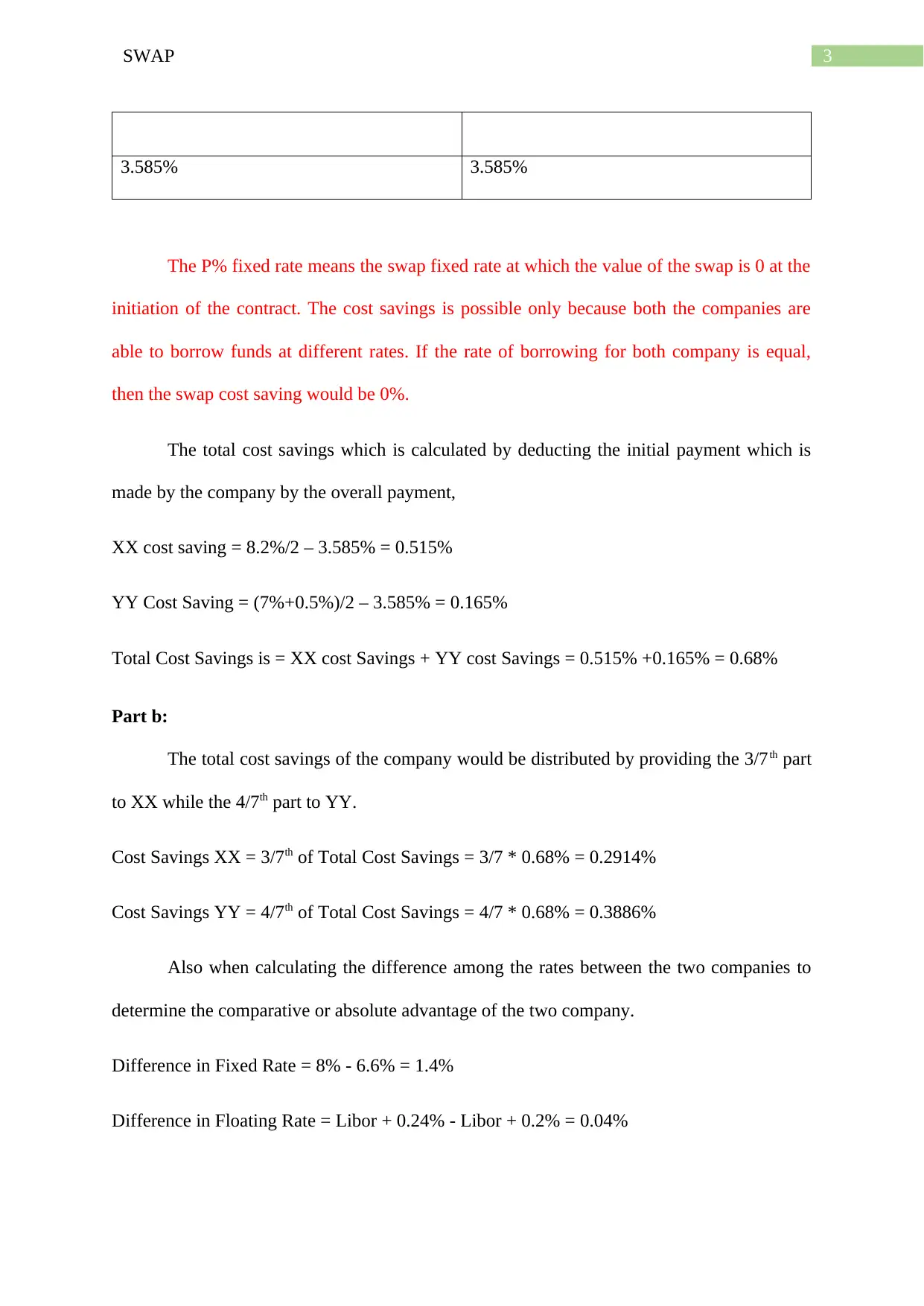
3SWAP
3.585% 3.585%
The P% fixed rate means the swap fixed rate at which the value of the swap is 0 at the
initiation of the contract. The cost savings is possible only because both the companies are
able to borrow funds at different rates. If the rate of borrowing for both company is equal,
then the swap cost saving would be 0%.
The total cost savings which is calculated by deducting the initial payment which is
made by the company by the overall payment,
XX cost saving = 8.2%/2 – 3.585% = 0.515%
YY Cost Saving = (7%+0.5%)/2 – 3.585% = 0.165%
Total Cost Savings is = XX cost Savings + YY cost Savings = 0.515% +0.165% = 0.68%
Part b:
The total cost savings of the company would be distributed by providing the 3/7th part
to XX while the 4/7th part to YY.
Cost Savings XX = 3/7th of Total Cost Savings = 3/7 * 0.68% = 0.2914%
Cost Savings YY = 4/7th of Total Cost Savings = 4/7 * 0.68% = 0.3886%
Also when calculating the difference among the rates between the two companies to
determine the comparative or absolute advantage of the two company.
Difference in Fixed Rate = 8% - 6.6% = 1.4%
Difference in Floating Rate = Libor + 0.24% - Libor + 0.2% = 0.04%
3.585% 3.585%
The P% fixed rate means the swap fixed rate at which the value of the swap is 0 at the
initiation of the contract. The cost savings is possible only because both the companies are
able to borrow funds at different rates. If the rate of borrowing for both company is equal,
then the swap cost saving would be 0%.
The total cost savings which is calculated by deducting the initial payment which is
made by the company by the overall payment,
XX cost saving = 8.2%/2 – 3.585% = 0.515%
YY Cost Saving = (7%+0.5%)/2 – 3.585% = 0.165%
Total Cost Savings is = XX cost Savings + YY cost Savings = 0.515% +0.165% = 0.68%
Part b:
The total cost savings of the company would be distributed by providing the 3/7th part
to XX while the 4/7th part to YY.
Cost Savings XX = 3/7th of Total Cost Savings = 3/7 * 0.68% = 0.2914%
Cost Savings YY = 4/7th of Total Cost Savings = 4/7 * 0.68% = 0.3886%
Also when calculating the difference among the rates between the two companies to
determine the comparative or absolute advantage of the two company.
Difference in Fixed Rate = 8% - 6.6% = 1.4%
Difference in Floating Rate = Libor + 0.24% - Libor + 0.2% = 0.04%
Paraphrase This Document
Need a fresh take? Get an instant paraphrase of this document with our AI Paraphraser
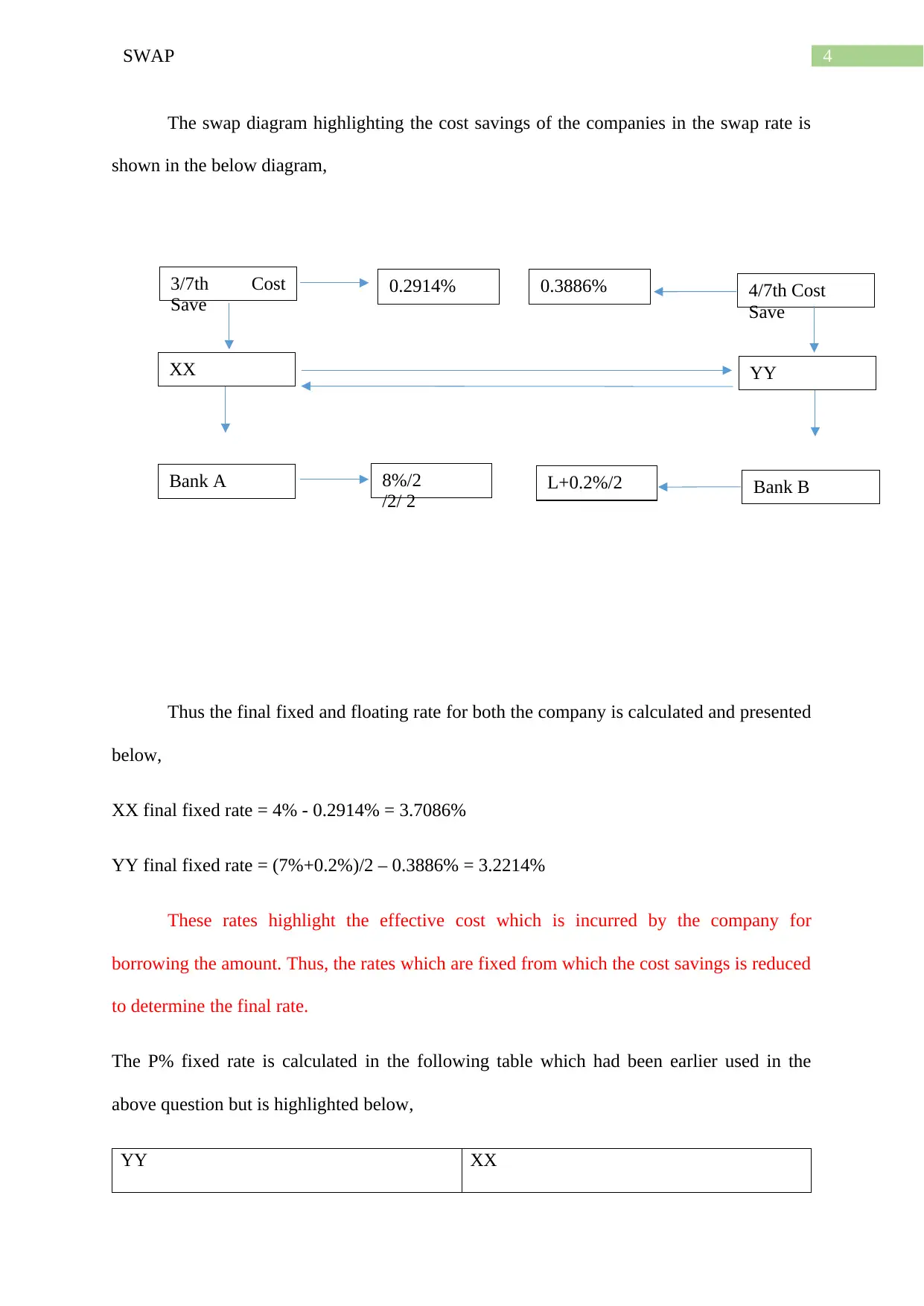
4SWAP
3/7th Cost
Save 4/7th Cost
Save
XX YY
Bank A Bank B
0.2914% 0.3886%
8%/2
/2/ 2
L+0.2%/2
The swap diagram highlighting the cost savings of the companies in the swap rate is
shown in the below diagram,
Thus the final fixed and floating rate for both the company is calculated and presented
below,
XX final fixed rate = 4% - 0.2914% = 3.7086%
YY final fixed rate = (7%+0.2%)/2 – 0.3886% = 3.2214%
These rates highlight the effective cost which is incurred by the company for
borrowing the amount. Thus, the rates which are fixed from which the cost savings is reduced
to determine the final rate.
The P% fixed rate is calculated in the following table which had been earlier used in the
above question but is highlighted below,
YY XX
3/7th Cost
Save 4/7th Cost
Save
XX YY
Bank A Bank B
0.2914% 0.3886%
8%/2
/2/ 2
L+0.2%/2
The swap diagram highlighting the cost savings of the companies in the swap rate is
shown in the below diagram,
Thus the final fixed and floating rate for both the company is calculated and presented
below,
XX final fixed rate = 4% - 0.2914% = 3.7086%
YY final fixed rate = (7%+0.2%)/2 – 0.3886% = 3.2214%
These rates highlight the effective cost which is incurred by the company for
borrowing the amount. Thus, the rates which are fixed from which the cost savings is reduced
to determine the final rate.
The P% fixed rate is calculated in the following table which had been earlier used in the
above question but is highlighted below,
YY XX
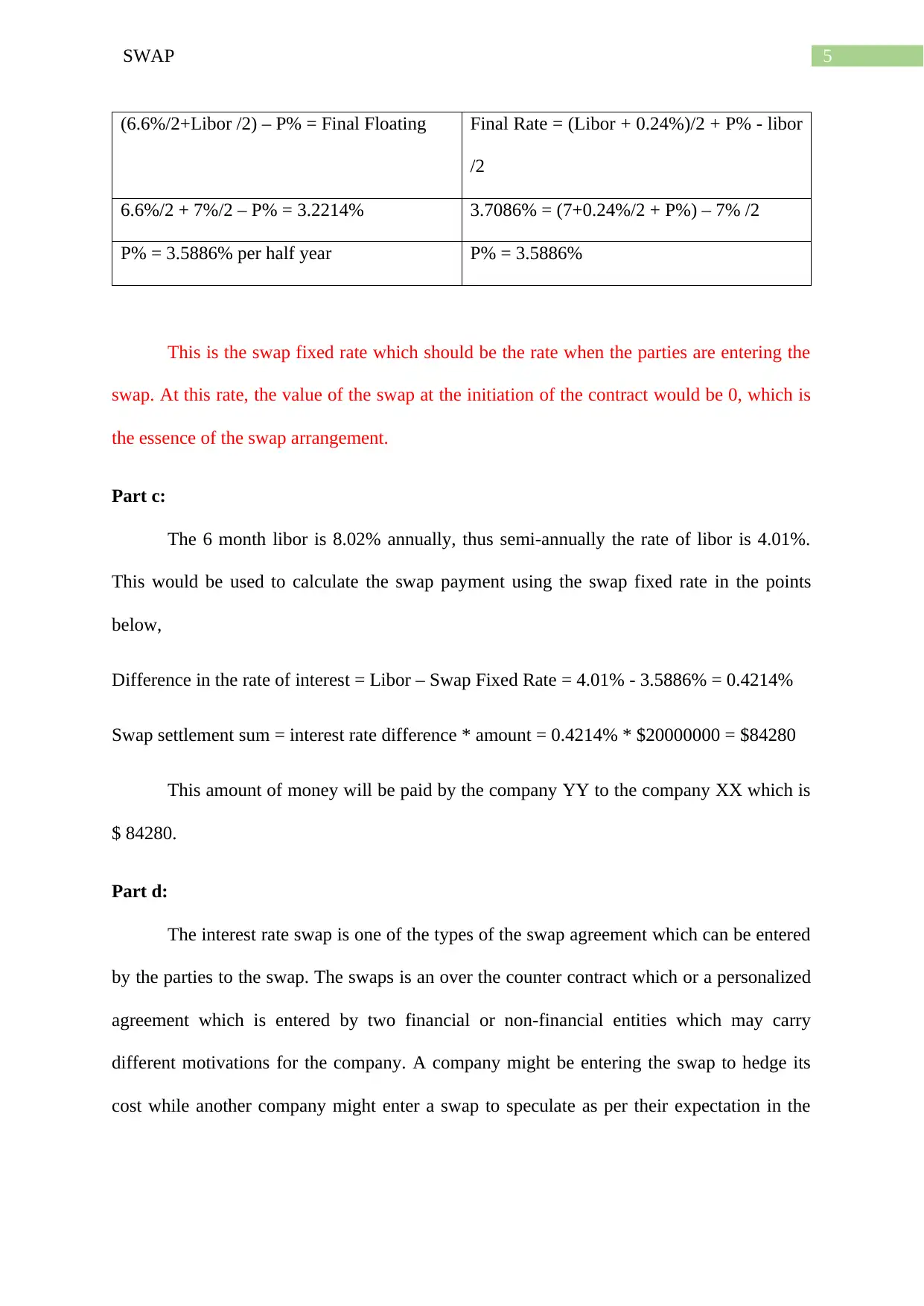
5SWAP
(6.6%/2+Libor /2) – P% = Final Floating Final Rate = (Libor + 0.24%)/2 + P% - libor
/2
6.6%/2 + 7%/2 – P% = 3.2214% 3.7086% = (7+0.24%/2 + P%) – 7% /2
P% = 3.5886% per half year P% = 3.5886%
This is the swap fixed rate which should be the rate when the parties are entering the
swap. At this rate, the value of the swap at the initiation of the contract would be 0, which is
the essence of the swap arrangement.
Part c:
The 6 month libor is 8.02% annually, thus semi-annually the rate of libor is 4.01%.
This would be used to calculate the swap payment using the swap fixed rate in the points
below,
Difference in the rate of interest = Libor – Swap Fixed Rate = 4.01% - 3.5886% = 0.4214%
Swap settlement sum = interest rate difference * amount = 0.4214% * $20000000 = $84280
This amount of money will be paid by the company YY to the company XX which is
$ 84280.
Part d:
The interest rate swap is one of the types of the swap agreement which can be entered
by the parties to the swap. The swaps is an over the counter contract which or a personalized
agreement which is entered by two financial or non-financial entities which may carry
different motivations for the company. A company might be entering the swap to hedge its
cost while another company might enter a swap to speculate as per their expectation in the
(6.6%/2+Libor /2) – P% = Final Floating Final Rate = (Libor + 0.24%)/2 + P% - libor
/2
6.6%/2 + 7%/2 – P% = 3.2214% 3.7086% = (7+0.24%/2 + P%) – 7% /2
P% = 3.5886% per half year P% = 3.5886%
This is the swap fixed rate which should be the rate when the parties are entering the
swap. At this rate, the value of the swap at the initiation of the contract would be 0, which is
the essence of the swap arrangement.
Part c:
The 6 month libor is 8.02% annually, thus semi-annually the rate of libor is 4.01%.
This would be used to calculate the swap payment using the swap fixed rate in the points
below,
Difference in the rate of interest = Libor – Swap Fixed Rate = 4.01% - 3.5886% = 0.4214%
Swap settlement sum = interest rate difference * amount = 0.4214% * $20000000 = $84280
This amount of money will be paid by the company YY to the company XX which is
$ 84280.
Part d:
The interest rate swap is one of the types of the swap agreement which can be entered
by the parties to the swap. The swaps is an over the counter contract which or a personalized
agreement which is entered by two financial or non-financial entities which may carry
different motivations for the company. A company might be entering the swap to hedge its
cost while another company might enter a swap to speculate as per their expectation in the
⊘ This is a preview!⊘
Do you want full access?
Subscribe today to unlock all pages.

Trusted by 1+ million students worldwide
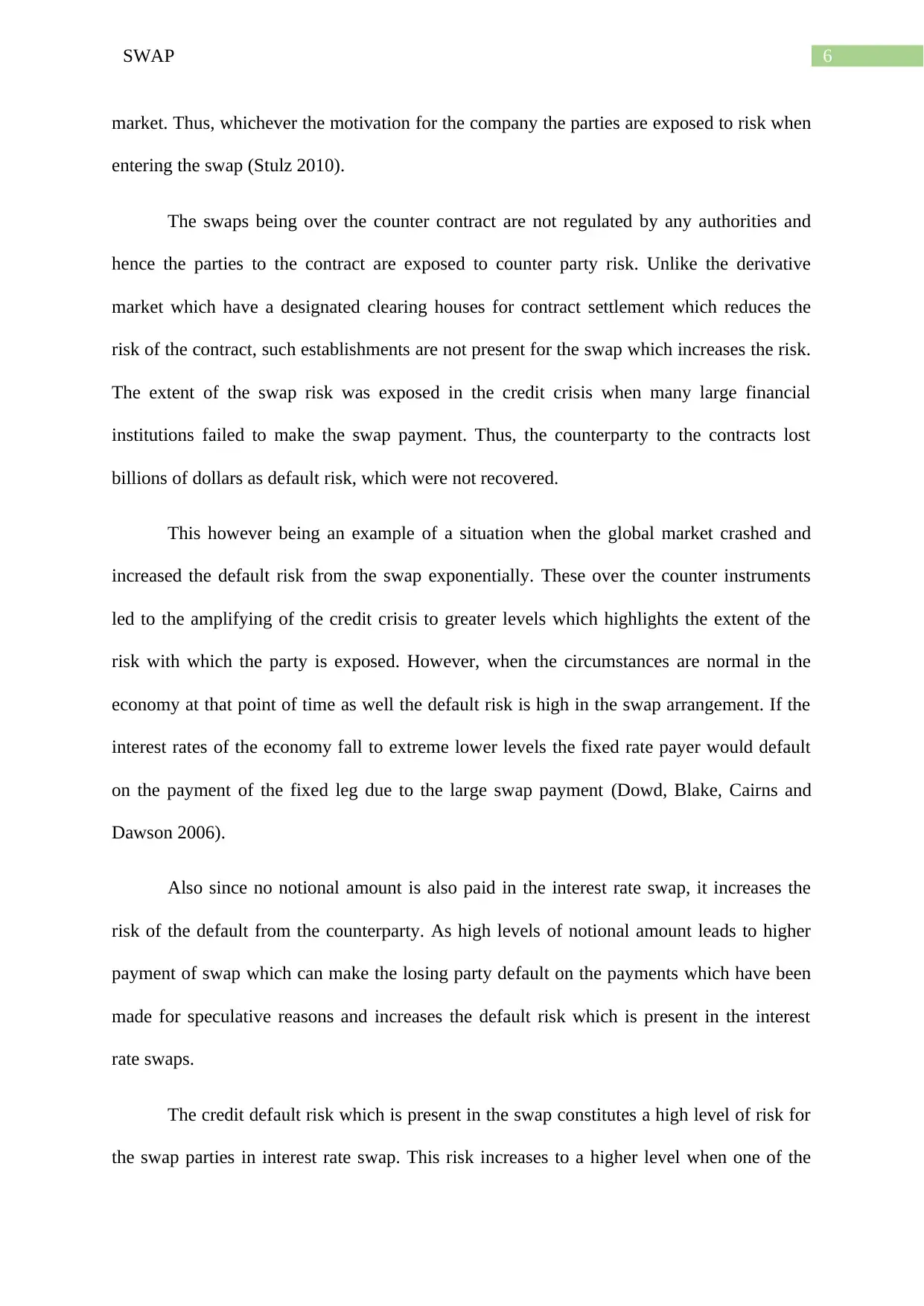
6SWAP
market. Thus, whichever the motivation for the company the parties are exposed to risk when
entering the swap (Stulz 2010).
The swaps being over the counter contract are not regulated by any authorities and
hence the parties to the contract are exposed to counter party risk. Unlike the derivative
market which have a designated clearing houses for contract settlement which reduces the
risk of the contract, such establishments are not present for the swap which increases the risk.
The extent of the swap risk was exposed in the credit crisis when many large financial
institutions failed to make the swap payment. Thus, the counterparty to the contracts lost
billions of dollars as default risk, which were not recovered.
This however being an example of a situation when the global market crashed and
increased the default risk from the swap exponentially. These over the counter instruments
led to the amplifying of the credit crisis to greater levels which highlights the extent of the
risk with which the party is exposed. However, when the circumstances are normal in the
economy at that point of time as well the default risk is high in the swap arrangement. If the
interest rates of the economy fall to extreme lower levels the fixed rate payer would default
on the payment of the fixed leg due to the large swap payment (Dowd, Blake, Cairns and
Dawson 2006).
Also since no notional amount is also paid in the interest rate swap, it increases the
risk of the default from the counterparty. As high levels of notional amount leads to higher
payment of swap which can make the losing party default on the payments which have been
made for speculative reasons and increases the default risk which is present in the interest
rate swaps.
The credit default risk which is present in the swap constitutes a high level of risk for
the swap parties in interest rate swap. This risk increases to a higher level when one of the
market. Thus, whichever the motivation for the company the parties are exposed to risk when
entering the swap (Stulz 2010).
The swaps being over the counter contract are not regulated by any authorities and
hence the parties to the contract are exposed to counter party risk. Unlike the derivative
market which have a designated clearing houses for contract settlement which reduces the
risk of the contract, such establishments are not present for the swap which increases the risk.
The extent of the swap risk was exposed in the credit crisis when many large financial
institutions failed to make the swap payment. Thus, the counterparty to the contracts lost
billions of dollars as default risk, which were not recovered.
This however being an example of a situation when the global market crashed and
increased the default risk from the swap exponentially. These over the counter instruments
led to the amplifying of the credit crisis to greater levels which highlights the extent of the
risk with which the party is exposed. However, when the circumstances are normal in the
economy at that point of time as well the default risk is high in the swap arrangement. If the
interest rates of the economy fall to extreme lower levels the fixed rate payer would default
on the payment of the fixed leg due to the large swap payment (Dowd, Blake, Cairns and
Dawson 2006).
Also since no notional amount is also paid in the interest rate swap, it increases the
risk of the default from the counterparty. As high levels of notional amount leads to higher
payment of swap which can make the losing party default on the payments which have been
made for speculative reasons and increases the default risk which is present in the interest
rate swaps.
The credit default risk which is present in the swap constitutes a high level of risk for
the swap parties in interest rate swap. This risk increases to a higher level when one of the
Paraphrase This Document
Need a fresh take? Get an instant paraphrase of this document with our AI Paraphraser
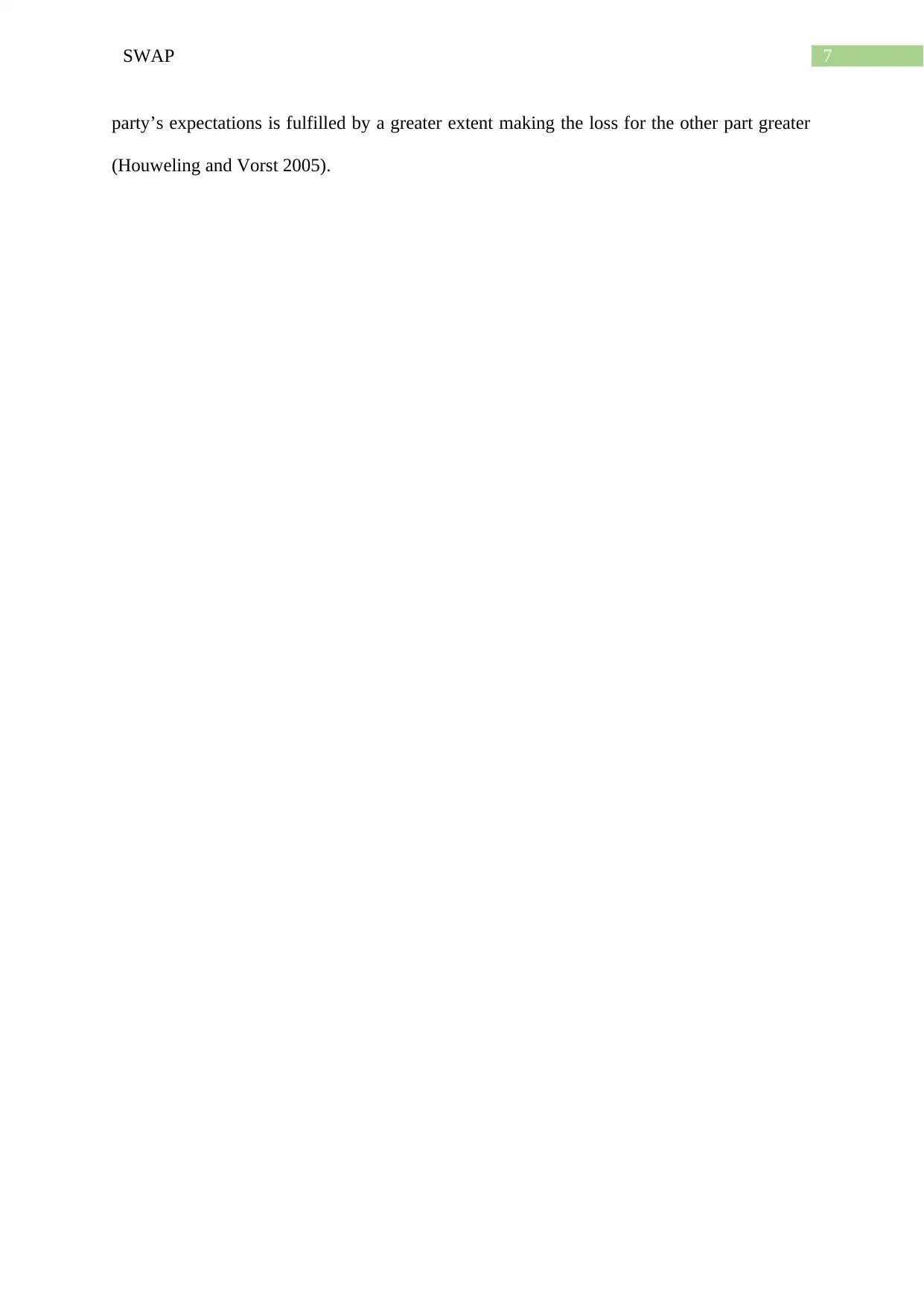
7SWAP
party’s expectations is fulfilled by a greater extent making the loss for the other part greater
(Houweling and Vorst 2005).
party’s expectations is fulfilled by a greater extent making the loss for the other part greater
(Houweling and Vorst 2005).
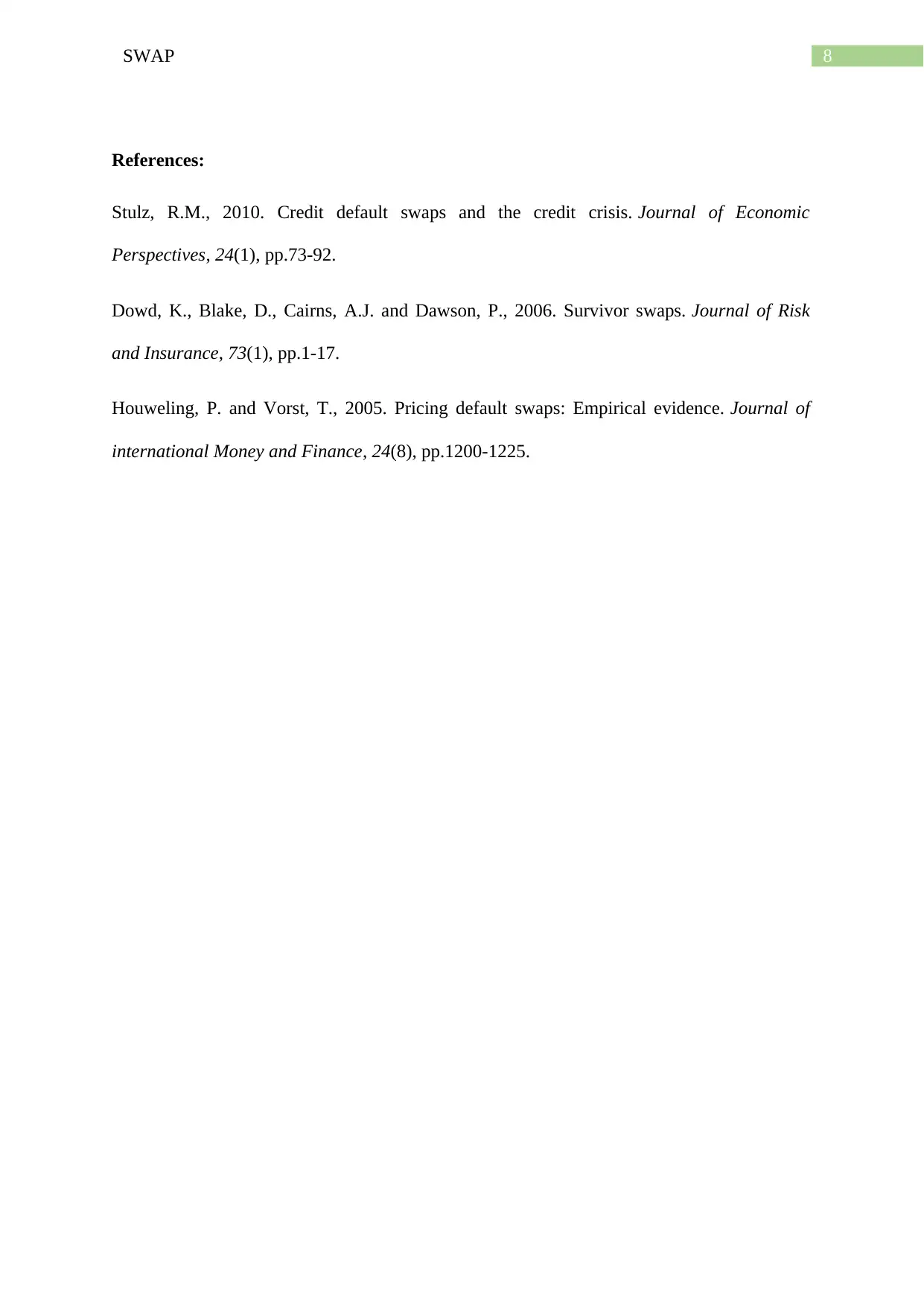
8SWAP
References:
Stulz, R.M., 2010. Credit default swaps and the credit crisis. Journal of Economic
Perspectives, 24(1), pp.73-92.
Dowd, K., Blake, D., Cairns, A.J. and Dawson, P., 2006. Survivor swaps. Journal of Risk
and Insurance, 73(1), pp.1-17.
Houweling, P. and Vorst, T., 2005. Pricing default swaps: Empirical evidence. Journal of
international Money and Finance, 24(8), pp.1200-1225.
References:
Stulz, R.M., 2010. Credit default swaps and the credit crisis. Journal of Economic
Perspectives, 24(1), pp.73-92.
Dowd, K., Blake, D., Cairns, A.J. and Dawson, P., 2006. Survivor swaps. Journal of Risk
and Insurance, 73(1), pp.1-17.
Houweling, P. and Vorst, T., 2005. Pricing default swaps: Empirical evidence. Journal of
international Money and Finance, 24(8), pp.1200-1225.
⊘ This is a preview!⊘
Do you want full access?
Subscribe today to unlock all pages.

Trusted by 1+ million students worldwide
1 out of 9
Your All-in-One AI-Powered Toolkit for Academic Success.
+13062052269
info@desklib.com
Available 24*7 on WhatsApp / Email
![[object Object]](/_next/static/media/star-bottom.7253800d.svg)
Unlock your academic potential
Copyright © 2020–2025 A2Z Services. All Rights Reserved. Developed and managed by ZUCOL.


